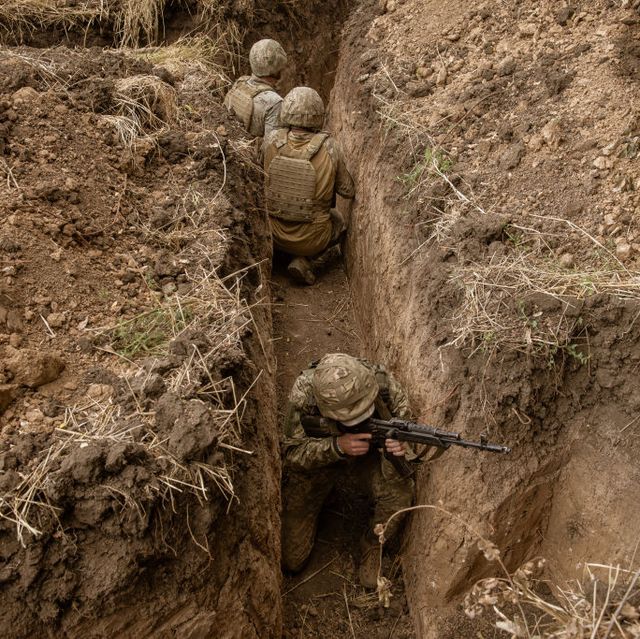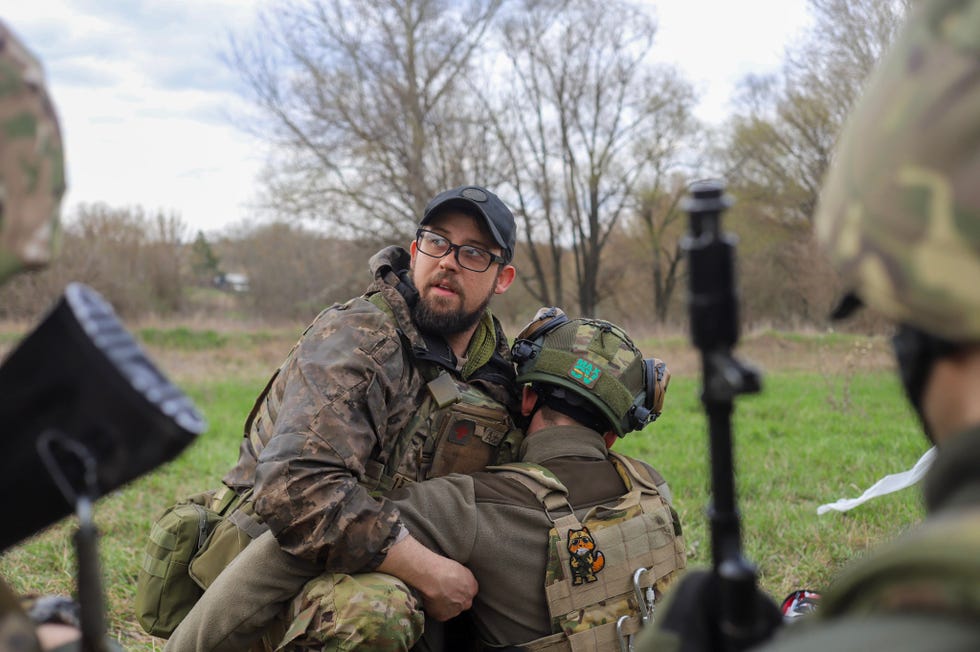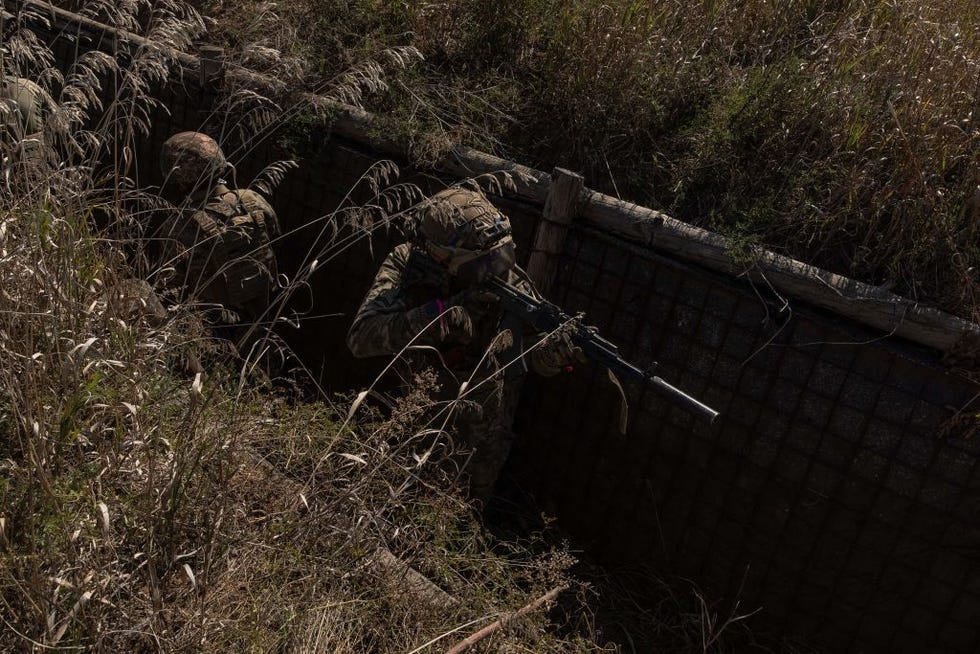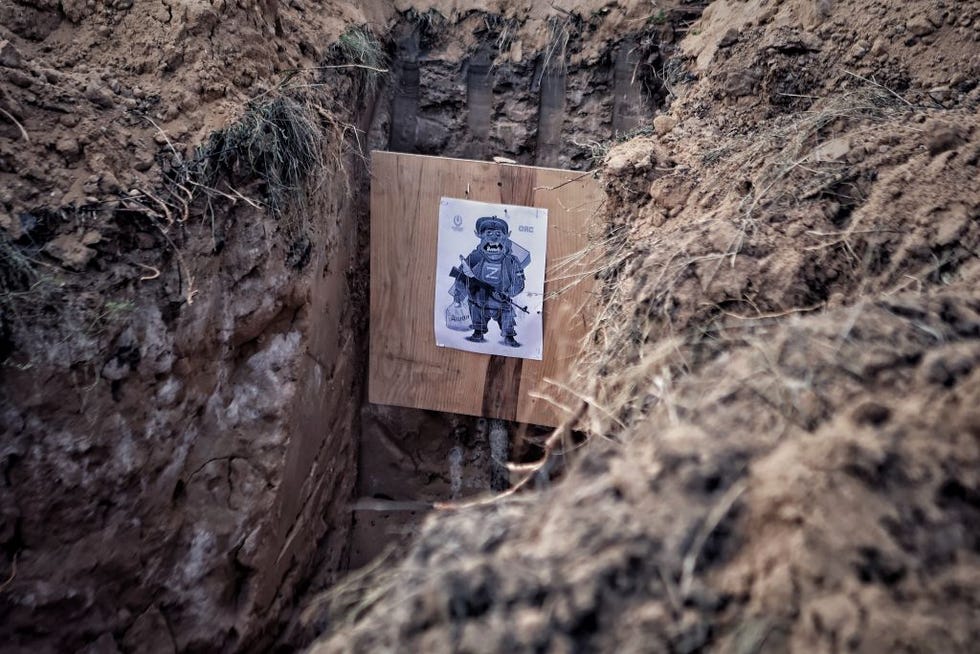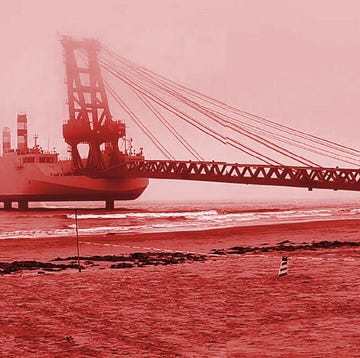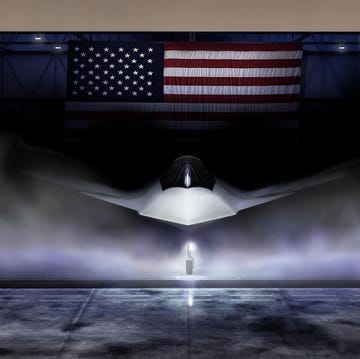DONETSK REGION, UKRAINE—“Advance! Five bogies, take cover! Fire!” These are the commands Kevin Leach and his team of Canadian colleagues are shouting to the assembled recruits of Ukraine’s Fourth Rapid Reaction Brigade. The men latch on to every word, keen to soak up every morsel of information—knowing can be the difference between life and death on Ukraine’s remorseless battlefields.
As part of Ukraine’s counteroffensive, these troops must approach and breach some of the most formidable military fortifications seen in Europe since World War II. Ukrainian and American officials admit the counteroffensive has made slower-than-expected progress since it began in June 2023, largely due to the density of these defenses. The summer came and went without a major Ukrainian breakthrough.
Built at various degrees of depth over the 600-mile or so frontline, the defenses start with “tank traps” designed to slow down advancing armor, supported by huge minefields, layers of barbed wire, and concrete pillboxes full of Russian soldiers armed with anti-tank weapons. In the meantime, advancing Ukrainians are coming under heavy fire from Russian artillery and air power.
The training ground, near the city of Kostyantynivka in eastern Ukraine, is calm. But just over 30 kilometers away, pitched battles were raging in and around the city of Bakhmut, where you could hear the faint whump and thud of artillery in the distance. Despite the urban area of the city eventually falling to the Russians after a ten-month-long slog, Ukraine has since launched a counteroffensive that has reclaimed parts of the region around Bakhmut, threatening to encircle and trap Russian troops inside the city. The Fourth Rapid Reaction Brigade is now crucial to these efforts.
It has been more than a year since a Ukrainian counteroffensive swept through the plains of the Kharkiv region, reclaiming thousands of square kilometers in just under a week. Russia’s defenses were weak, and Ukrainian armor and artillery were able to smash through them with ease. Some hoped the Ukrainians could produce similar results in the east and south of the country this year.
But Ukraine’s current counteroffensive has not progressed nearly as fast. The Russian Army, which was ridiculed for its poor performance last year, has belatedly learned its lessons.
Instead, Ukrainians have been trying to point to another counteroffensive from last year toward the southern city of Kherson. Here, Ukrainian forces fought a grinding attritional battle across flat, open countryside before gradually wearing down Russian troops and forcing them to retreat.
Layers of Trenches
Ukraine has focused its main effort in the region of Zaporizhzhia, where its forces have advanced from the small city of Orikhiv to reach the occupied city of Melitopol, known as the “gateway to Crimea.” This would sever the land bridge that connects the occupied peninsula to the Donetsk region, also occupied by Russia, and thereby the Russian mainland. It is the prerequisite for any Ukrainian assault to take back the last remnants of occupied territory. But it won’t come easy.
“They’ve had in many places over a year to dig in, so they will have three, maybe four, layers of trenches … you also have mortars and artillery to deal with,” Leach, whose Saber team unit of private military trainers has spent months preparing the Ukrainians for this battle, says of the Russians. But the most significant obstacle has been huge Russian minefields, he tells Popular Mechanics. “The minefields are much deeper, and people were not prepared for this. This has made it very difficult for Ukraine to push through.”
To counteract these obstacles, Ukraine has received large amounts of Western equipment, including German-made Leopard tanks and U.S. Bradley Armored Fighting Vehicles. Large numbers of this kit were destroyed in the initial days when Ukraine tried to breach these defenses with a mechanized push. After this, they switched to dismounted infantry tactics where teams of sappers slowly disarmed Russian mines one by one.
All this makes the training that Saber has been conducting—focused on slow, methodical movement of infantry through trench lines—even more vital.
Finding the Weak Points
Ukraine has taken back perhaps a dozen small settlements since June. Most significant has been the liberation of the town of Robotyne in the Zaporizhzhia direction, one of the most heavily fortified Russian strongholds on the southern line.
One soldier in Ukraine’s 68th Jaegar brigade, who took part in the liberation of the village of Staromaiorske in the Donetsk region, described the difficulties involved with taking these areas.
“We need to find weak points,” he tells Popular Mechanics. “The best is to bypass by the side and find a weak spot. That’s what we do now. It’s called reconnaissance in force. We went in, realized they entrenched well, and then we stepped back and tried another place. In some places, it will crack. The line can’t be perfect everywhere. There must be a weak spot.
“You can think of probing attacks as ‘where to put the wedge’ and now the offensive is moving into a point where you hammer it open. The ideal breakthrough would look like control of a wide enough corridor through Russian lines that they can start moving regular transportation through—right now, if you wanted to, you could press an armored attack through the lines with armored vehicles and tanks. What a sustainable breakthrough looks like is moving regular military vehicles.”
Ukrainian forces have been using vehicles beyond the Russian defensive lines in the region of Robotyne, but they have been fighting slowly toward the village of Verbove. A larger breakthrough to the Sea of Azov seems unlikely, at least this year.
Risk and Reward
Ukraine has made slow progress in its counteroffensive, sparking a blame between Kyiv and its Western partners.
Western officials, particularly in recent anonymous briefings to American newspapers, have criticized Ukrainian tactics, saying they have spread their forces too thin, and are unwilling to take the necessary risks and casualties to breach Russian lines. Ukrainian soldiers, including a commander from Ukraine’s 128th Territorial Defense Brigade, grumble to me that Western training was inadequate for the task ahead of them.
Leach agrees with the Ukrainians, and thinks U.S. criticisms are unfair, saying that Western doctrine could not have prepared Ukrainians for the difficulties they’re now facing.
“Western nations haven’t dealt with minefields of this complexity and depth since we were going through German ones in World War II. Our warfighting doctrine is: ‘you’ll go around it, but there is no going around them.’” He also points out that Ukraine is advancing without air superiority, which is why Kyiv has consistently called on NATO partners to speed up the delivery of F-16 fighter jets to provide cover for advancing troops.
The Biden administration is taking steps it hadn’t previously considered to give Ukraine the best chance of breaching the Russian defenses. The most controversial move has been the delivery of Dual-Purpose Improved Conventional Munitions (DPICMs), a form of cluster munition banned in over 100 countries. While the U.S., Ukraine, and Russia are not party to the Convention on Cluster Munitions prohibiting these weapons, it has drawn criticism from even members of Biden’s party, who believe that the risk to civilians is simply too high.
Leach explains that he thinks the risks are worth it, considering the military context in which these weapons will be used. “The damage is done now, for ERW [explosive remnants of war]. A field that is mined is as dangerous as a field that had cluster munitions fired at it. We’re going to spend years making Donbas safe for civilians. The American munitions do have a lower dud rate, but I believe the threat they pose is outweighed by their utility. … I think that people are reflexively opposing their use as a result of marketing, so to speak. I think their utility is poorly understood, unlike mines.” Regardless, he points out, the Russians will be using cluster munitions on the Ukrainians.
After the war, Leach believes, it will likely be the Ukrainians training NATO forces, instead of the other way around. “These are problems being solved in real-time by Ukrainians. NATO and the West are going to learn from what the Ukrainians have been doing here.”
